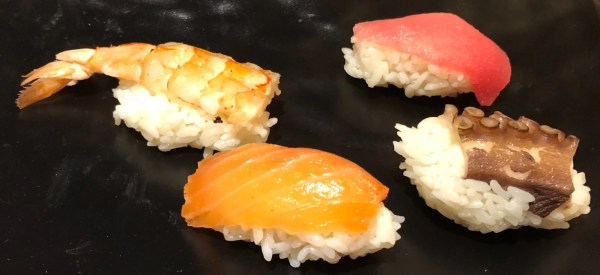I don’t consider mixing seafood and cheese to be a sin. I’ve even personally suffered the roll the eyes wrath of snotty servers when I’ve asked for parmesan on my pasta alla vongole or on my risotto con camarones. But even I have limits and where those limits get really tested is with sushi. I don’t know why…and I’ve tried very hard to find out…but Mexicans think that, right behind rice, the most important ingredient in sushi is Philadelphia cream cheese.
An example: Arigato, the latest entry into the San Miguel sushi scene. The restaurant located on Calle Mesones has 24 different maki, the Japanese word for those rolls of rice enclosing or topped almost always with seafood. 23 of those 24 include cream cheese. That’s more even than the 17 that include seafood. Not only that, of those 23 that have cream cheese, 9 also have Manchego cheese. Arigato does quite well with young Mexican clientele but I doubt you’ll ever see me occupying a stool there ever again.
I want sushi one day a week. Every week. So I am on a constant San Miguel search for what the Japanese call edomae nigirizushi which loosely translates as sushi that is very special. But it is a real struggle. Flor de Loto, California Kitchen and Delica Mitsu are gone. Sushi Itto is hardly worth a mention. Sushi Gami is just OK. And I’m not even sure the 1826 bar even has sushi these days.
But I have good news. There’s another restaurant in San Miguel de Allende serving very promising sushi. And if you already know about it I would be very surprised. For it has little or no street presence. Not even a sign.

It’s called Sushi 23. And it’s what part of Kuna Doni, the restaurant on Salida de Celaya becomes at my…and perhaps your…drinking hour of 5:00 pm. Francisco García took over Kuna Doni a couple of years ago and with the help of his son Polo and Chef José Ramirez they have added Japanese cuisine to their offerings.

“I knew the town needed better sushi”, said Francisco, “and I knew José could deliver it.”

José Ramirez had good training. He worked under Chef David Behnke at MX, the San Miguel restaurant that, a few years ago, on weekends, produced some of the best sushi at their upstairs bar that this town has ever seen.
How the Mexicanization of sushi happened I’m not sure. Javier Cabral who writes for Munchies says, “It all started when a customer at a sushi restaurant in Sinaloa asked the chef for ‘something different’ one day. That led the sushi chef to procure a sizzling piece of carne asada from the taqueria across the street and create a sushi roll with it. Thus, Mexican sushi was born.” And Sushi 23 is definitely not void of the Japanese/Mexican fusion or Mexipan cuisine as I call it.
There’s a roll with arrachera. Another that does include that dreaded cream cheese. And something that the restaurant is very proud of called los íncreibles tacos de sushi. But, overall, Sushi 23 comes close to capturing the original Japanese experience.w

There’s a choice of four nigiri, those oblong blocks of rice topped with seafood. All the toppings have been previously frozen but, in Toronto, where there are over 300 bars, probably less than 20 offer much of anything that’s fresh. Plus, all the seafood that Chef José has chosen…shrimp, salmon, tuna and octopus…all freeze well.

Sushi 23 knows that nigiri should always be served with wasabi and soy (other San Miguel sushi restaurants don’t) and Don Day’s Wife knows that nigiri should be eaten with your fingers not chopsticks and should be dipped in the wasabi and soy upside down so that only the seafood and not the rice is immersed (though neither she nor I can tell you how to do it without the rice falling apart).

José Ramirez knows the importance of good rice, the importance of it being suitably sticky and nutty, and Sushi 23’s rice is good rice.

The best way to start your meal is with soup. José bends tradition a little with his first choice. The first choice is miso, the soup that, amazingly, is consumed an average of more than once a day in Japan. Miso soup always consists of dashi stock made from ingredients such as dried baby sardines and miso paste made from fermented soybeans and a fungus known as kogikin. The Japanese will often add seaweed, tofu, mushrooms and scallions and, occasionally, other ingredients. Purists may, however, be aghast at Chef José’s addition of noodles until, like me, they tasted them. Sushi 23 owner Francisco García shared with me that the rice noodles are sourced from an Asian food supplier in Celaya. They have both texture and taste making them some of the best noodles both Don Day’s Wife and I have ever had.

Those same scrumptious noodles can also be found in Sushi 23’s other Japanese style soup, ramen. Now this is not one of those hearty whole meals in a bowl made from roasted pork bone stock but it has nice additions such as shrimp, slices of pork and hard boiled egg and makes a nice alternative to the miso. Even nicer, it’s a ramen that doesn’t fill you to the brim, leaving lots of room to split a couple of Sushi 23’s makis or rolls.

Sushi 23 has made the same mistake that so many Japanese restaurants make. They have given flashy names to their maki that do little to tell people what’s in them. There are one or two word descriptions that give you some idea of what to expect but not much. And unless you have young grandkids…and not even average, everyday grandkids…not the ones who watch Thomas The Tank Engine but the ones who watch Japanese anime, you’ll have no idea who or what Goku, Kame, Goten, Nappa, Krilin and Red Fury are.
My solution has been to simply say to José bring me the ones you are most proud of and don’t stray too far from the Japanese classics. And that has worked wonderfully.

One of the best rolls is a visually stunning combination of salmon, avocado, smoked eel and flying fish roe.

The spicy tuna is much more simple but just as satisfying. A sprinkle of sesame seeds would add even more to the mix and, if José takes my suggestion, they may be there by the time you get there.

Even one of the Mexipan rolls is an almost essential maki to try if for no other reason than its innovation. Chef José has taken the classic Mexican dish, chiles en nogada, and Mexipanized it to great acclaim from me. The fruit, nuts and meat are wrapped in rice instead of being stuffed in a poblano pepper and covered in the traditional nougat sauce and pomegranate seeds. It’s sweet, so I’d save it until the end of the meal. And I can’t help mention the who pays for the next drink games you can invent, challenging people to pick up those cream covered seeds with chopsticks.

I should also note that there may be one reason you might want to pass on the sushi en nogada and that’s to save room for José Ramirez‘ homemade ice cream (I solve the problem by ordering both but definitely sharing). I’ve had the vanilla ice cream. I’ve had the mango. I’ve had the fig. So far, three for three.
I’m going to anticipate one question that I’m going to receive after I publish this blog post. It’s going to be along these lines: “I absolutely adore sushi but my husband won’t go near it. He’s not exactly excited about vegetables deep fried in tempura batter either. Is there anything there for him?”

My answer is a very loud “yes”. Kuni Doni’s everyday Mexican menu is always available and there’s even one Asian-style dish that a no raw fish guy might go for, a superb seared tuna steak on a bed of noodles.
Sushi 23 is located inside Kuni Doni at Salida a Celaya #24 in San Miguel de Allende, Mexico. They Japanese menu is offered from 5:00 to 8:30 pm, seven days a week.


Accordng to Super Sushi ches, Fish Shoud be frozen for sushi/sashimi!
Looking forward to trying this out..
We read your reviews often and last night went with others to find some great sushi.. we had been to Kuni Doni before and thought perhaps they had moved because it was closed and dark? Did they move? Are they open really 7 days a week? Que lastima. We were really disappointed.
Linda
Queso Filadelfia seems to be an essential part of sushi all over Latin America. I thought that was bad enough, but then the local Mikono franchisee told me that warm rice is now the default.
So, a month or so ago, I’m at Superama, and I decide to order a plate of sushi made up with the store’s sole offering that doesn’t include cheese, making sure to tell the sushi maker “no cheese,” just for good measure. 10 min. later when I go over to pick it up, it’s made up with queso Filadelfia. I remind the sushi maker what I’d ordered and even about my special request, and he insists he was just following the recipe. Dragging him over to my side of the counter to show him the recipe, he tells me “You can’t have sushi without queso Filadelfia.” Well, I didn’t have sushi that day.
Just curious if you have ever had the sushi at Sushi Roll in Celaya.
If so, how do they compare with Sushi 23?
I haven’t. Should I try it?
I must admit Sushi Roll is the best I’ve had in San Miguel area. They even offere a Spider Roll (fried small soft shell crab). And of course there are many rolls with Filadelfia but many without.
http://www.sushiroll.com.mx/menu/
The menu has no pricing but when the bill comes it is usually reasonable. Check it out!
I’ve never really found Edo style sushi outside my favorite places in Tokyo although at various places around the world, I’ve had innovative and good tasting rolls.
What I was told the 1st time I went to Tokyo and wandered around was to always sit at the serving bar and after the traditional egg sushi to establish the restaurant restaurant worth, to then order tokujo which got me the highest quality selection.
Not sure if I will get back to Japan but I will sometimes try for tokujo and hope that I will get the quality the name deserves although it is usually disappointment
I am a fan of Japanese cuisine, of course sushi and sashimi. (I hate Surimi, once I visited a factory where it is made.) But I was deeply shocked when in a Japanese restaurant in León almost all sushi had been “raped” by cheese. When I ordered my Hakushika, do not warm up, but please at room temperature, it was served on ice. Fortunately the bottle was not empty yet.
Isn’t it chilies en nogada?
Correct. I broke the rule of never publishing without my proofreader (aka Don Day’s Wife) reading it.
https://www.thrillist.com/eat/nation/7-unforgivable-food-faux-pas-you-must-avoid – take a gander at the sushi faux pas
Best word: Mexipanized. Really looking forward to tonight!
Yes, and it is not even cream cheese by name. It is always Filadefia (variable spellings). And the word/”recipe” is spreading. Perhaps owing in my native city/former home to the many Mexicans who work in kitchens, I now have seen cream cheese-listed sushi on NYC menus.
Can’t wait to try this out!
I think Sushi Gami deserves more credit than you give them. They do a great job and they deliver. A real plus
They have catered parties for us. Their presentation and quality have been super. Our guests loved their sushi